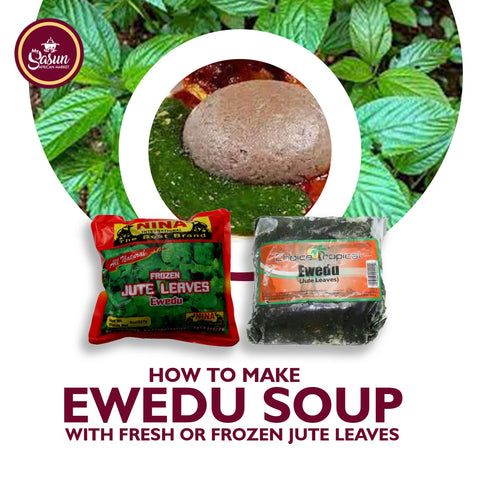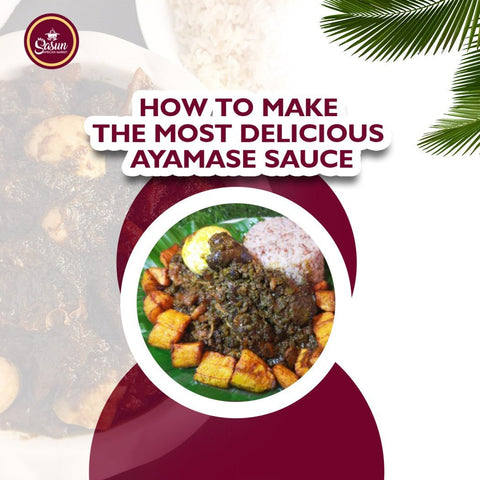Welcome to the heartwarming world of Nigerian cuisine, where every dish tells a story and every flavor takes you on a journey. Today, we're rolling up our sleeves to whip up a Nigerian feast that's as nourishing for the soul as it is for the body. This meal is a staple in Nigerian homes, especially for people of the Yoruba tribe of Nigeria. It is a hearty combo that symbolizes hospitality and community. Let's get started with our delicious Amala, Abula (a combination of Ewedu and Gbegiri), and the irresistible Buka Stew.

Amala
Amala is a traditional Nigerian dish, particularly popular among the Yoruba ethnic group in the southwestern part of the country. It’s a type of “swallow” food, which means it’s a starchy ball typically eaten with soups or stews and swallowed without chewing. Amala is made from yam, cassava flour, or unripe plantain flour. The tubers are peeled, sliced, cleaned, dried, and then ground into flour. Here’s a breakdown of what Amala is and its varieties:

Types of Amala:
Àmàlà Isu (Yam Flour): This is yam-based and is the most common type. It’s made from a particular species of yam known as Dioscorea cayenensis because of its high starch content. When added to boiling water, it turns a black/brownish color.
Àmàlà Láfún (Cassava Flour): Made from cassava flour, it’s also known as lafun in Nigeria and konkonte in Ghana.
Amala Ogede (Plantain Flour): Made from unripe plantain flour, it’s lighter in color and suitable for diabetics due to its lower carbohydrate content.
Also Read: HOW TO MAKE THE BEST AFRICAN GROUNDNUT SOUP
Health Benefits of Amala
Amala is rich in carbohydrates and is an important source of energy. The yam flour variant is high in dietary fiber, which can help reduce low-density lipoproteins.
How to make the Best Amala
Pure yam flour
Water.
Method:
- Boil water in a pot.
- Gradually stir in yam flour.
- Keep stirring until it becomes smooth and firm.
- Mold into balls and serve warm.
EWEDU SOUP

Ewedu, also known as jute leaves, is a traditional soup native to the Yoruba people of Nigeria. It’s known for its slimy texture when cooked, similar to okra, and is often served with dishes like Amala, Eba, Pounded yam, or fufu. The soup is not only popular in West Africa but also in the Middle East, East Africa, and North Africa, where it’s known as Mulukhiyah or Molokhia.
The preparation and serving of ewedu vary by region. For instance, in some areas, the leaves are dried for later use or made into tea, while others prefer it fresh, often served over white rice. In Nigeria, it’s commonly paired with a bean-based stew called gbegiri and a protein like meat or fish stew.
How to make the best Ewedu Soup that draws
To make ewedu soup, you’ll need fresh or frozen jute leaves, water, locust beans for flavor (optional), crayfish, salt, and bouillon powder. Some recipes may call for potash to enhance viscosity, but it’s not necessary if the leaves are cooked properly.
Here are four easy methods to prepare Ewedu soup:
1. With Blender (No Potash):
Ingredients:
- 3 cups of jute (ewedu) leaves
- 2 tablespoons of locust beans (iru)
- 1 tablespoon of ground crayfish (optional)
- 1 seasoning cube (optional)
- Salt to taste
Instructions:
-
Buy fresh ewedu leaves, pick only the leaves (no stems), and wash them thoroughly.
-
Blend the leaves with a little water using a blender.
-
In a pot, add the blended ewedu, locust beans (if not blended earlier), ground crayfish (optional), seasoning cube (optional), and salt to taste.
-
Cook for about 2 minutes (do not overcook). Allow it to cool; it will continue cooking with retained heat.
-
Serve with gbegiri and buka stew and eat with amala or any preferred swallow.

2. With Ijabe (Traditional Broom):
Ingredients:
- 3 cups of jute (ewedu) leaves
- 2 tablespoons of locust beans (iru)
- 1 tablespoon of ground crayfish (optional)
- 1 seasoning cube (optional)
- Salt to taste
- 1 potash (kaun)
Also Read: HEALTH BENEFITS AND PRECAUTIONS OF USING POTASH IN COOKING

Instructions:
-
Pluck the ewedu leaves from the stalk, wash them, and place in a pot with a little water and potash.
-
Cook until the leaves are soft.
-
Use an Ijabe (broom) to pound the leaves until you achieve the desired viscosity.
-
Add a little water, locust beans, crayfish, seasoning cube, and salt to taste. Stir and cook for 2-5 minutes.
-
Serve with your preferred swallow.
3. Ewedu Elegusi Soup (With Ground Egusi Seeds):
Ewedu Elegusi Soup is a delicious variation that combines the slimy texture of Ewedu soup with the rich flavor of Egusi (melon seeds). Here’s a simple recipe to make Ewedu Elegusi Soup:
Ingredients:
Fresh Ewedu leaves
Ground Egusi (melon seeds)
Locust beans (Iru)
Bouillon cube (optional)
Salt to taste
Instructions:
Prepare the Ewedu:
Wash and chop the Ewedu leaves.
Boil two cups of water in a pot and add the Ewedu leaves.
Cook for about 15 minutes or until the leaves are soft.
Blend the Ewedu leaves with a blender or a broom until smooth and slimy.
Cook the Egusi:
In a separate pot, mix the ground Egusi with a little water to form a paste.
Add the Egusi paste to the pot and stir well.
Combine and Season:
Add the locust beans, crayfish powder, bouillon cube, and salt to the Ewedu soup.
Stir well and simmer for another 10 minutes or until the Egusi is cooked through.
Serve:
Enjoy your Ewedu Elegusi Soup with your preferred swallow or bread.

N.B: Remember that overcooking the leaves can affect the viscosity and flavor of the ewedu, so be careful.
Health Benefits of Ewedu Soup
Ewedu is nutritious, containing vitamins A, C, E, calcium, fiber, protein, and more. It’s associated with several health benefits, such as:
Acne prevention and treatment: Due to its vitamin A content, it can help control sebum secretion.
Strengthening bones and teeth: It’s rich in calcium and phosphorus, which are essential for maintaining bone density.
Aiding digestion: The fiber in ewedu promotes digestive health and can help prevent constipation.
Weight loss: Its fiber content also supports metabolism and weight management.
Skin and hair health: Ewedu contains fatty acids and vitamins that contribute to skin moisture and collagen production, as well as Omega 3 for hair growth.
Also Read: HOW TO MAKE EWEDU SOUP WITH FRESH OR FROZEN JUTE LEAVES
GBEGIRI SOUP

Gbegiri soup is a traditional Nigerian dish, particularly popular among the Yoruba ethnic group. It's a smooth and flavorful soup made primarily from peeled beans, often black-eyed peas or honey beans. The soup is known for its creamy texture and is often part of a meal combination called "Abula," which includes the soup alongside ewedu and buka stew, creating a rich and diverse flavor experience. It's a dish that's deeply rooted in Nigerian culinary tradition and is enjoyed in various social gatherings and everyday meals.
Here's a simple and tasty recipe for Gbegiri Soup:
HOW TO MAKE GBEGIRI SOUP THE EASY WAY
Ingredients:
- 1 ½ cups Black-Eyed Peas (or honey beans)
- 1 Medium Onion, finely chopped
- 6 cups Water
- 4 tablespoons Palm Oil
- 2 tablespoons Ground Crayfish
- 1 tablespoon Locust Beans (Iru or Dawadawa - optional)
- 1 Stock Cube (Maggi, Knorr, or any preferred seasoning)
- Salt, to taste
Instructions:
- Prepare the Beans:
- Soak the black-eyed peas for about 10-15 minutes to soften them.
- Peel the beans by rubbing them between your palms and rinsing in cold water to remove the skins.
- Cook the Beans:
- Place the peeled beans in a pot with the chopped onion and water.
- Cook for about 1 hour on the stovetop or 25 minutes in a pressure cooker until the beans are very soft.
- Blend the Beans:
- Once the beans are soft, blend them to achieve a smooth, creamy texture.
- Cook the Soup:
- Return the blended beans to the pot.
- Add the palm oil, ground crayfish, locust beans, stock cube, and salt.
- Cook on low heat for about 5 minutes or until the oil changes from red to yellow, indicating that it has fully integrated with the soup.
- Adjust and Serve:
- Adjust the seasoning and consistency of the soup to your preference.
- Serve hot with your choice of Nigerian swallow, especially amala and a side of ewedu and buka stew.
BUKA STEW

Buka stew is a rich and flavorful Nigerian stew that is a staple in many homes and local eateries known as “bukas” or “mama put” in Nigeria. It’s known for its deep red color, which comes from a tomato base (Nigerian pepper mix) and palm oil. The stew is typically made with assorted meats like goat meat, beef, shaki (tripe), ponmo (cow skin), and sometimes fish or chicken. It’s a versatile dish that can be served with a variety of sides such as rice, bread, or traditional Nigerian swallows like pounded yam or fufu.
The process of making Buka stew involves cooking the meat until tender, blending and boiling down peppers and tomatoes to form a thick base, and then frying this base in palm oil. Onions, scotch bonnet chillies, and traditional seasonings like beef or chicken bouillon cubes are added to enhance the flavor. Some recipes also include powdered ginger and garlic for additional taste.
One of the key aspects of Buka stew is the use of palm oil, which should not be compromised. It gives the stew its authentic taste and aroma. The palm oil is often bleached before being used in the stew, which contributes to its unique flavor profile. The stew is cooked slowly to allow the flavors to meld together and the oil to float to the top, indicating that it’s well-cooked.
Buka stew is not just a meal; it is culture! It is Nigeria! t’s enjoyed by people from all walks of life and is a proof of the rich heritage of Nigeria.
Also Read: COOKING THE PERFECT OHA SOUP: A STEP-BY-STEP GUIDE
HOW TO MAKE THE MOST DELICIOUS BUKA STEW
Here's a delicious recipe for Buka Stew that exudes authentic flavors:
Ingredients:
- 7 Tattase (red bell peppers)
- 4 Tomatoes
- 1 Big Onion
- 5 Habanero Peppers
- 1 ½ cups Palm Oil
- Salt (to taste)
- Water (or meat stock, as needed)
- Assorted meats (goat meat, beef, shaki (tripe), ponmo (cow skin))
- Beef or chicken bouillon cubes
- Powdered ginger and garlic (optional)
Instructions:
- Prepare the Meats:
- Wash the assorted meats and place them in a pot.
- Season with salt, bouillon cubes, and a bit of chopped onion.
- Cook until the meats are tender.
- Make the Pepper Base:
- Blend the tattase, tomatoes, and habanero peppers until smooth.
- Pour the blend into a pot and boil until it reduces by half and thickens.
- Bleach the Palm Oil:
- Heat the palm oil in a pot until it changes to a lighter color. Be careful not to overheat.
- Allow the oil to cool slightly before proceeding to the next step.
- Cook the Stew:
- Chop the big onion and fry in the bleached palm oil until translucent.
- Add the boiled pepper mix and stir.
- Let it cook for about 10 minutes, then add the meat stock to enhance the flavor.
- Add the cooked meats to the stew and let it simmer.
- Adjust the seasoning with salt and bouillon cubes if needed.
- If you're using powdered ginger and garlic, add them now.
- Continue cooking until the oil floats to the top of the stew.
- Serve:
- Serve your Buka Stew hot with your choice of side—rice, bread, or traditional Nigerian swallow.

NUTRITIONAL BENEFITS OF BUKA STEW
Rich in Protein: The assorted meats used in Buka stew provide a good source of protein, which is essential for building and repairing tissues in the body.
Vitamins and Minerals: The red bell peppers and tomatoes used in the stew are high in vitamins A and C, as well as minerals like potassium and magnesium.
Antioxidants: Tomatoes contain lycopene, an antioxidant that may help protect against certain types of cancer.
Healthy Fats: Palm oil, used in Buka stew, contains tocotrienols, a form of vitamin E that has antioxidant properties.
Conclusion
Preparing Amala, Abula, and Buka Stew is a delightful experience that brings a piece of Nigerian culture into your kitchen. It's a meal that's sure to impress, with its rich flavors and nutritional benefits. So go ahead, give it a try and savor the taste of Nigeria home. You can trust My Sasun African Market to supply all your African food ingredients and more, if you live in the US or Canada/ Jump on the website now or walk into either of our stores to place your orders.







Comments (2)
My heart is so filled with joy. If you are suffering from Erectile dysfunction or any other disease you can contact Dr. Moses Buba on this buba.herbalmiraclemedicine@gmail.com or His website : https://www.facebook.com/profile.php?id=61559577240930 . For more information from me reach me via WhatsApp : +44 7375 301397
This is so detailed. Thanks and well done!